ConvertKit Vs Mailchimp is a considerable debate for people in the market to choose the Best Email Marketing Software to use to implement their digital marketing practices.
Finding the right email marketing software for your business is somewhat of a necessity nowadays. Otherwise, you won’t be able to grow your business. Email marketing software is used for:
- Build your brand name.
- Boost sales of your products (even affiliates).
- Convert customers/potential clients.
So, one needs to be actively informed about these marketing software as spending your marketing budget is a decision that should not be taken lightly. Once you do some research, you’ll find that Mailchimp and ConvertKit are the two major players in this industry; that’s why we are here, bringing you a comparison of which one is the best email marketing software overall.
Both of the software offers almost the same set of features with slight variations here and there. They offer features like Landing Pages, Contact Tagging, Forms, Automations, etc. There is a clear distinction in both of these software (based on their clients) as most of the established businesses use Mailchimp, whereas ConvertKit is what is used by bloggers or entrepreneurs.
Here’s a detailed discussion on ConvertKit Vs Mailchimp, determining which one is the best email marketing tool.
Setup
When it comes to Mailchimp Vs ConvertKit setup, both software has an easy-to-use design, and you can perform the setup task within a few clicks.
Starting with ConvertKit, the software offers a user-friendly step-by-step process to ask about your current systems preferences, goals, and websites. Once you’re done, they will show you a welcome video explaining everything about the software. From there, you can move straight into setting up your contacts list by uploading it or by performing manual data entry.
ConvertKit calls its campaigns ‘Broadcasts.’ After uploading your contact list, you can directly launch a campaign afterward. The only factor which makes you struggle a little bit is specifying the sender details and listing subscribers before you’ll be able to create your email.
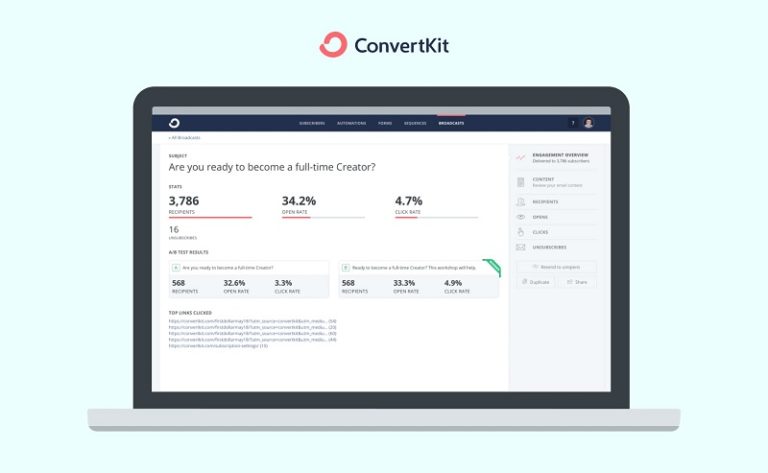
On the other hand, Mailchimp’s setup makes it stand out from the rest of the competition as you can build your email by following a small step-by-step process and then start creating your content list. You can send it to whomever you want to once the entire content list has been completed.
Further, the software allows you to edit your campaign content through their already integrated design templates, along with access to a simple drag and drop editor. These basic setup features make Mailchimp one of the most used email marketing tools globally as per its intuitive nature.
User-Friendliness & Editing
According to the fans of these email marketing software, these tools are user-friendly, and even a noob can start using them without any formal training.
Mailchimp’s user interface offers easy navigation, is flexible, and you can create an email over it by following a simple step-by-step procedure. The software provides their users with the liberty to either start with designing their email or select the potential recipients and add sender details first.
The editor of Mailchimp has an interface of drag and drop where you can add or remove elements based on your desire and strategy. Also, you can edit text, apply variations to your images and styles. One thing that requires mentioning here is the ‘undo button,’ which is only available when editing texts.
In contrast, ConvertKit also offers easy navigation and has their email builder placed under ‘Broadcasts.’ The process of creating your email in CoverKit is opposite to that of Mailchimp. You have to initially specify sender details and the list of subscribers before moving on to creating your email.
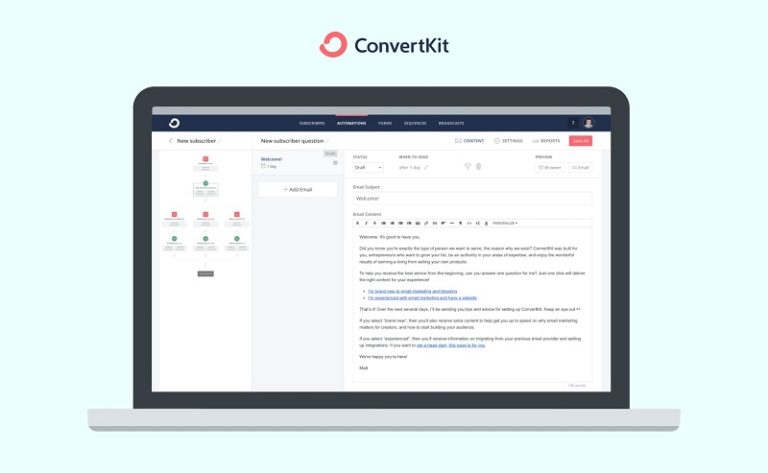
Looking at the similarities in Mailchimp vs. ConvertKit editors, ConvertKit’s editor has fewer optimization options, making it easy to use. Also, the email templates are text-based as they do not offer a drag and drop function in their editor. You can only change font color, sizes, the addition of images, and more. This email marketing software does not provide the users with an ‘Undo’ function, which can be frustrating sometimes.
Mailchimp allows you to send and receive regular email campaigns quickly, has a great visual brand, and the application is intuitive. The functions of list management and reporting data can be more user-friendly. However, these are advanced functions and do not cause an issue for a complete beginner-level email marketer.
List Management
Mailchimp allows its users to create lists of their contacts in various categories and keep them completely separate from each other. This makes the management of emails easy, thus enhancing your business efficiency. Also, your email marketing implementation will have a much more powerful impact.
Furthermore, the feature of multiple lists is charged separately by Mailchimp based on the duplication of contacts across various lists. You can also create tags to specify and identify whether the contact came from your signup form, subscribers list, or from some other source. Additionally, you also have the option to create segments via contact field criteria or groups. That will allow your contacts to self-categorize themselves once the process of signup is completed.
If you are running multiple projects simultaneously, then this list management feature in Mailchimp can act as a beneficial tool.
ConvertKit stays away from lists. Whenever you upload your contacts, they will all accumulate to the same referred place. This means that various lists of specific contacts cannot be created with ConvertKit. However, the software compensates its users by assigning their contacts to a form, tag, or sequence to organize them. Moreover, you can also create segments of contacts based on their homogenous characteristics.
The overall analysis of list management in both software tells us that ConvertKit is a bit less complicated than Mailchimp. If you are in the market for streamlined email marketing software, you can opt for ConvertKit. However, if you require software that allows you to make a few tweaks here and there, then Mailchimp is the product you are looking for.
Design & Flexibility
Now we are coming to the portion of the ConvertKit Vs Mailchimp debate where the differences in characteristics appear. They both have designed their software based on their research.
ConvertKits only has three options for their email designs which are:
- Modern
- Classic
- Text only.
This means that you can apply text formatting along with the addition of a few images using ConvertKit’s Classic & Modern templates. If you are one of those email marketers looking for a vast library of well-designed templates, then ConvertKit is not the software for you.
The reason behind ConverKit’s limited design functionality relies upon their own conducted research, which states that ‘plain-texts & simple emails perform much better in comparison to design-centric emails.’
On the other hand, Mailchimp has packed their software with 100+ themed templates which cover:
- Holiday emails.
- Newsletter
- E-invites
- E-Commerce promotions
- And much more…
In addition to those 100+ themed templates, they also offer 14 blank layouts, which you can customize and apply to your designs.
ConverKit’s fewer design options can be a huge turn-off for some marketers as people want more choices rather than less. However, many huge bloggers use ConvertKit and have hundreds and thousands of subscribers who love and cherish their simple text-based newsletters.
Forms
Mailchimp comes integrated with all types of forms which an email marketing expert can desire for. The variety of forms include:
- Pop-ups
- Hosted URLs
- Sign Up forms
- Forms that you can embed into your website
- etc.
Utilizing these forms offered by Mailchimp, you can direct people visiting your website to join your mailing list.
ConvertKit, on the other hand, has limitless signup forms, which are:
- GDPR (general data protection regulation) compliant.
- Can be customized, i.e., customizable.
- Responsive
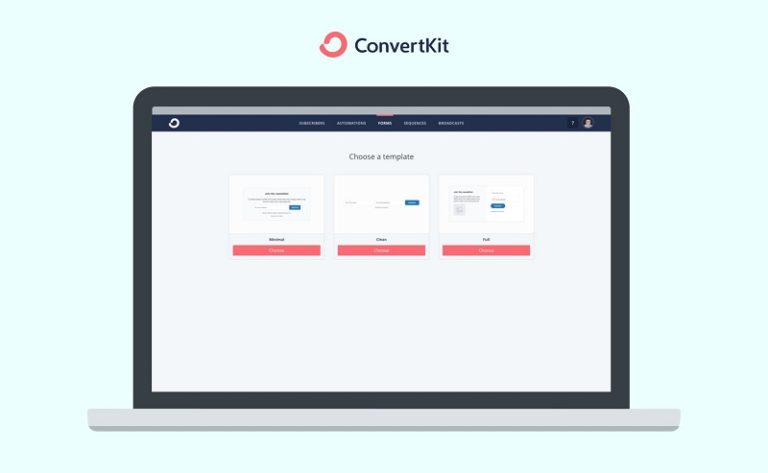
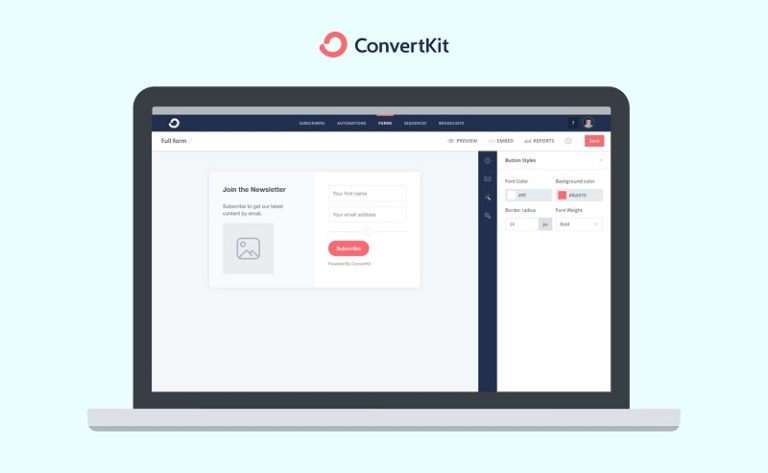
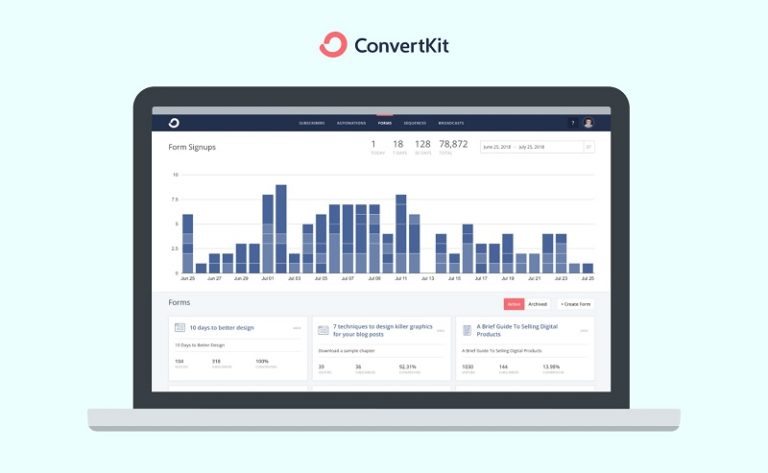
Further, you can add your form as an embedment, slide-in forms, pop-ups, and customize various design elements using custom CSS, images, and colors. You can also use ConvertKit to hide your form from repeated visitors so you wouldn’t get duplicate entries or spammy emails lists.
Mailchimp also allows you to embed forms, pop-ups, signups and let them go to the list of your choosing.
Marketing Automation
ConvertKit has recently integrated its software with the ‘Visual Automation’ feature. You can use that feature to build sequence emails, which means that once someone subscribes to your blog’s newsletter, they will get a sequence of welcoming and onboarding emails, which can deliver significant value to your email marketing strategy. You can edit your emails while building the sequences for it. Thus there is no need to jump to another section of the tool.
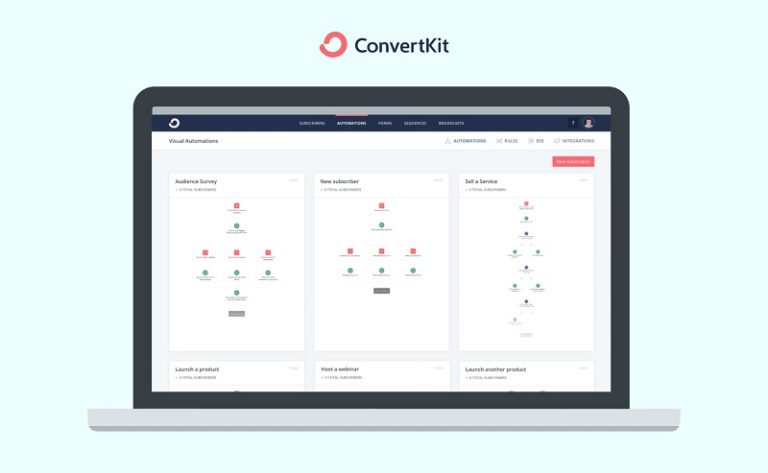
The Visual Automation feature of ConvertKit is a workflow-based editor that can help the user define in which sequence the signup form, purchase form, etc., should get completed. You also have the liberty to add steps depending upon the events, actions, and conditions of a particular form. In the end, you can add multiple sequences to automation and universal automation rules for the addition and removal of tags.
With ConverKit’s visual automation, you get plenty of features to automate your marketing process.
On the other hand, MailChimp can set up campaigns for you triggered by the number of webpage visits you get. The automation and visual editor feature of Mailchimp seems a bit outdated. It does not have such enhanced and advanced features as ConvertKit does. This makes Mailchimp easy to use and simple to set up for automated workflows.
Landing Pages
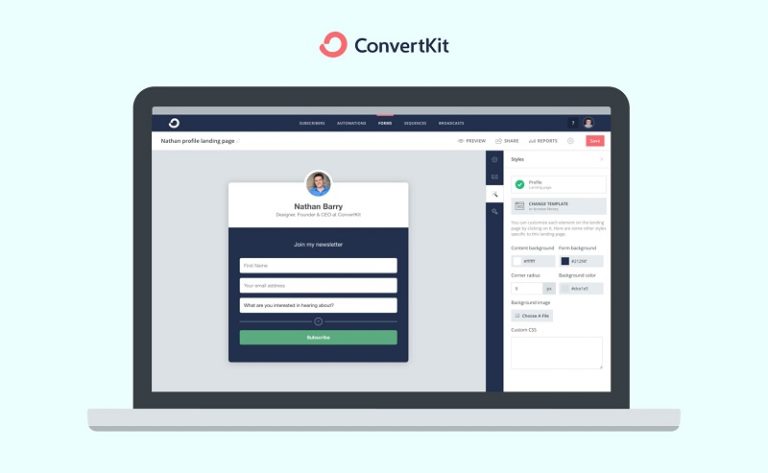
ConvertKit offers 50+ templates to build landing pages, and without a doubt, they are pretty aesthetic to look at. The editor of the landing pages is almost similar to the editor of creating forms. ConverKit doesn’t stop here; they also deliver clients’ reports, conversion rates, and subscribers. Lastly, you can also host the landing page on your website if you are not comfortable using the ConvertKit domain.
Coming to Mailchimp’s landing page editor, it is much easier to use than its form editor. It offers ten templates to its users and completely blank layouts where you can use the drag and drop function to create a limitless amount of designs. This design flexibility gives an edge to Mailchimp in the landing page department.
Like ConvertKit, you will get reports on website visits, subscribers, conversion rates, and clicks with Mailchimp landing page builder.
Reporting

The software’s report function does not cover bounce rate, geographical data, or click heat maps. The only factors or stats covered by the software are:
- Open rates
- Click rates
- Links clicked
- Unsubscribers
In addition to all of this, you are not given the liberty to rename your emails for internal purposes, which can be frustrating. For instance, if you have sent the same email to multiple audiences, and now you want to differentiate those emails based on their audience, you wouldn’t be able to distinguish between them with ConvertKit.
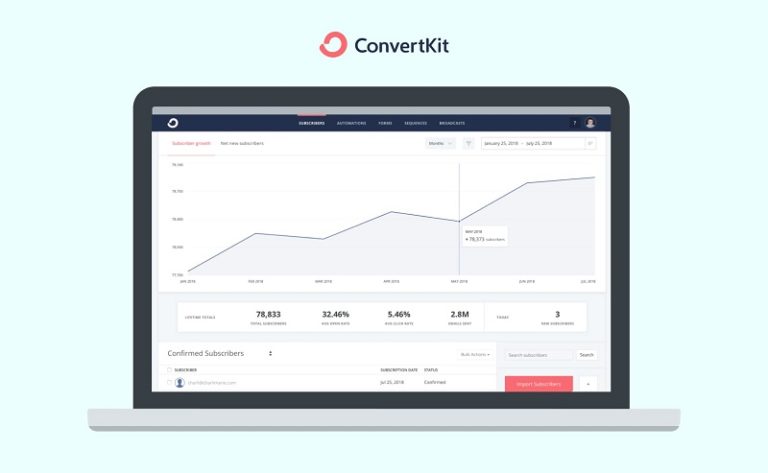
Mailchimp has countless reports it can generate for its clients depending upon the type of campaigns their clients are running. It offers reports like:
- Ecommerce sales
- Click maps
- Social stats
- Hourly performance report
- Performance by domain
- Opens by geographical locations
- etc
You can also extract extra data such as click rates, bounce rates, the number of complaints, etc.
So, when it comes to the ConvertKit Vs Mailchimp debate, Mailchimp beats ConvertKit by a long haul in the reporting department.
Customer Support
The customer support department of both ConvertKit and Mailchimp are pretty great. Live chat and Email support are both available for the users 24/7. Mailchimp’s live chat response is a bit slow in comparison to ConvertKit. However, Mailchimp’s guides and step-by-step processes are a bit more detailed than ConvertKit.
It isn’t easy to differentiate between the software’s customer support performance as they both operate at the same level in this department.
